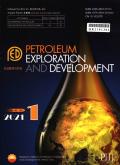Genetic mechanism and petroleum geological significance of calcite veins in organic-rich shales of lacustrine basin: A case study of Cretaceous Qingshankou Formation in Songliao Basin, China
IF 7
Q1 ENERGY & FUELS
引用次数: 0
Abstract
Based on the observation and analysis of cores and thin sections, and combined with cathodoluminescence, laser Raman, fluid inclusions, and in-situ LA-ICP-MS U-Pb dating, the genetic mechanism and petroleum geological significance of calcite veins in shales of the Cretaceous Qingshankou Formation in the Songliao Basin were investigated. Macroscopically, the calcite veins are bedding parallel, and show lenticular, S-shaped, cone-in-cone and pinnate structures. Microscopically, they can be divided into syntaxial blocky or columnar calcite veins and antitaxial fibrous calcite veins. The aqueous fluid inclusions in blocky calcite veins have a homogenization temperature of 132.5–145.1 °C, the in-situ U-Pb dating age of blocky calcite veins is (69.9±5.2) Ma, suggesting that the middle maturity period of source rocks and the conventional oil formation period in the Qingshankou Formation are the sedimentary period of Mingshui Formation in Late Cretaceous. The aqueous fluid inclusions in fibrous calcite veins with the homogenization temperature of 141.2–157.4 °C, yields the U-Pb age of (44.7±6.9) Ma, indicating that the middle-high maturity period of source rocks and the Gulong shale oil formation period in the Qingshankou Formation are the sedimentary period of Paleocene Yi'an Formaiton. The syntaxial blocky or columnar calcite veins were formed sensitively to the diagenetic evolution and hydrocarbon generation, mainly in three stages (fracture opening, vein-forming fluid filling, and vein growth). Tectonic extrusion activities and fluid overpressure are induction factors for the formation of fractures, and vein-forming fluid flows mainly as diffusion in a short distance. These veins generally follow a competitive growth mode. The antitaxial fibrous calcite veins were formed under the driving of the force of crystallization in a non-competitive growth environment. It is considered that the calcite veins in organic-rich shale of the Qingshankou Formation in the study area has important implications for local tectonic activities, fluid overpressure, hydrocarbon generation and expulsion, and diagenesis-hydrocarbon accumulation dating of the Songliao Basin.
湖相盆地富有机质页岩中方解石脉的成因机制及其石油地质意义:中国松辽盆地白垩纪青山口地层案例研究
在岩心和薄片观察分析的基础上,结合阴极发光、激光拉曼、流体包裹体和原位LA-ICP-MS U-Pb测年,研究了松辽盆地白垩系青山口组页岩中方解石脉的成因机制和石油地质意义。宏观上,方解石脉与层理平行,呈透镜状、S形、锥中锥状和羽状结构。显微镜下可分为句法块状或柱状方解石脉和反轴纤维状方解石脉。块状方解石脉中的水液包裹体均化温度为132.5-145.1 °C,块状方解石脉的原位U-Pb测年年龄为(69.9±5.2)Ma,表明青山口地层的源岩成熟中期和常规成油期为晚白垩世明水地层的沉积期。纤维状方解石脉中的水液包裹体均化温度为141.2-157.4 ℃,得到的U-Pb年龄为(44.7±6.9)Ma,表明青山口组源岩中高成熟期和古龙页岩成油期为古新世义安台地沉积期。合成块状或柱状方解石脉的形成对成岩演化和油气生成十分敏感,主要经历了三个阶段(裂缝张开、成脉流体充填、岩脉生长)。构造挤压活动和流体超压是断裂形成的诱导因素,成脉流体主要以短距离扩散方式流动。这些矿脉一般采用竞争生长模式。反轴纤维状方解石矿脉是在非竞争性生长环境的结晶力驱动下形成的。研究认为,研究区内青山口组富含有机质页岩中的方解石脉对松辽盆地的局部构造活动、流体超压、油气生成与排出以及成岩-油气聚集年代测定具有重要意义。
本文章由计算机程序翻译,如有差异,请以英文原文为准。
求助全文
约1分钟内获得全文
求助全文

 求助内容:
求助内容: 应助结果提醒方式:
应助结果提醒方式:


